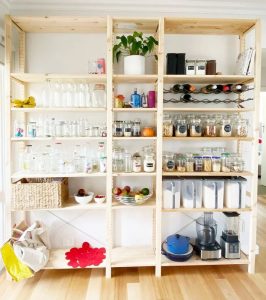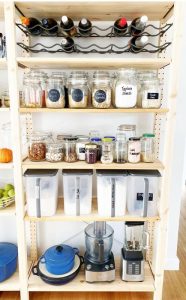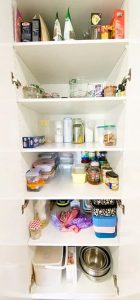Pantry audit – create a beautiful, functional and plastic-free pantry
This article has been written by Angela Chung, who lives in Macleod. Angela is a professional interior designer who used to operate her own small business called Pop-Up Pantry, which was an online store delivering pantry and household cleaning products direct to homes within 10km of Macleod.
 Have you ever felt it hard to find things in your pantry? Do you want to re-organise your pantry, but don’t know where you can start? Would you like to make your pantry much more functional and beautiful? I want to help you by sharing my tips from a recent pantry audit and organising session.
Have you ever felt it hard to find things in your pantry? Do you want to re-organise your pantry, but don’t know where you can start? Would you like to make your pantry much more functional and beautiful? I want to help you by sharing my tips from a recent pantry audit and organising session.
It’s a common experience to struggle to find things in the pantry and then end up dumping forgotten goods lurking at the back of the cupboard such as nuts and beans. But if you are inspired to create an organised, functional pantry, there is a way forward! For inspiration, I collected beautiful pantry images from Pinterest and got some fresh ideas from friends. Then it was time to set up my own plastic-free pantry.
The first step was to remove all the goods from your pantry, especially those in plastic packaging. Get yourself set up with new jars and containers, either by investing in good-sized new jars or by re-using your rescued jam/pickle jars. You can even find free jars that neighbours or local Facebook groups are offering. Just ask! If you are recycling and re-using jars, then make sure you thoroughly clean them in the dishwasher (ideally in heavy pot cleaning mode) and dry them well. Transfer all  dry ingredients to the new clean jars and label them with a paint pen or chalk pen (more on labelling options below).
dry ingredients to the new clean jars and label them with a paint pen or chalk pen (more on labelling options below).
The second step is to place the jars on your shelves, ideally not more than two rows deep. Place frequently used items at eye level. Heavy bulk items can go on the bottom. Adjust shelf heights if needed. Items should be visible and reachable. I have a 550mm deep pantry with cupboard doors, and my items were overflowing so I added some multi-storage shelves in my kitchen to help get organised. I installed the Ivar adjustable modular shelves from Ikea because I can re-use them in a different setting in future. I wanted to use the new shelving for as long as possible, so I chose eco-friendly, plastic-free pine timber with steel pins. A modular flexible shelving system from a local hardware store or Ikea is inexpensive and can be re-configured and get a second life in the future, as your needs change. Purchasing secondhand bookshelves is another great option.
The third step is to re-fill your jars rather than buying pre-packaged food. This will make your pantry beautiful, functional and sustainable. The best way is to find a bulk refill store that you like, and bring your empty jars or produce bags when you shop. That’s why I started Pop-up Pantry, to fill a need in my local suburbs. You can order organic package-free goods online, which come in brown paper bags, which you then re-use or compost. We are also trialing a jar-swap system, for people who hire a set of our standard jars.  The friendliest way is to come to our pop-up store every Tuesday, at 39 Finlayson Street in Rosanna. Call (0481 113 690) before to let us know you are coming, ideally also saying what you are likely to want.
The friendliest way is to come to our pop-up store every Tuesday, at 39 Finlayson Street in Rosanna. Call (0481 113 690) before to let us know you are coming, ideally also saying what you are likely to want.
Another tip for setting up jars is, for similar goods, to stick to the same shape or size, making them easy to arrange on shelves. Choose the jars carefully and consider easy stock items for future purchase. 1L and 0.5L are a great size for frequent use items such as nuts, oats, and dry fruits. Small recycled jars are good for dried fruits, tea, salt and spices. 5-10L airtight plastic containers are appropriate for bulk rice and flour.
Finally, for labelling, there are a few great options. The key is to use simple, flexible, and easily removable labelling because the jars will need to be washed from time to time. Typical sticker type labels are hard to remove and I prefer to use paint pens or chalk pens. Both can be applied directly to the glass jars and stay on well. A chalk pen can be applied to the chalk label sticker that is easily removable for re-use. The good thing about chalk labels is that they give a uniform look regardless of the different shape and size of jars. The downside to the chalk pen is it’s not waterproof. If used a the container holding liquid, the paint pen will do the job. To remove the paint marker, rub jars with steel wool, and use methylated spirits for plastic containers, then wash with dishwashing liquid. There is an embossing label maker available if handwriting is not your thing. Just make sure to keep using the plastic label tapes.
The result! Look at my beautiful new pantry shelves with all my kitchen essentials.

Terrific article, Angela. Lots of useful hints. The labelling hints solve a problem for me.